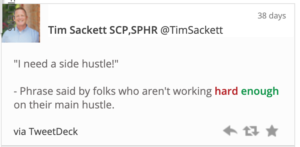I’m out at O.C. Tanner’s Influence Greatness conference this week and got a sneak peek at their 2020 Global Cultural Report by the O.C. Tanner Institute and it’s loaded with some exceptional findings! O.C. Tanner puts more money into their research than almost any other HR Tech company on the planet, so it’s well worth checking out. This report surveyed 20,000 people and over 12.8 million data points.
The research is based on O.C. Tanner’s model of “Talent Magnets” of which there are six:
- Wellbeing
- Leadership
- Purpose
- Opportunity
- Success
- Appreciation
While every single one of these is important in their own right, they also all work together. Lift one, and you will lift the rest. As you can imagine the highest-rated magnet is Purpose. Having a clear purpose to why you do the work you do has the highest impact on positive engagement.
So often I find people believing their job or their company has no purpose, but everyone does and every organization does. You might not believe in it, or agree with it, but the purpose is there. Part of the being a strong magnet is pulling in others who do believe in your purpose.
Wellbeing is another one that is interesting. On the outside, we see “wellbeing” and we think physical wellbeing, but in reality, in terms of being a talent magnet, it’s probably more social wellbeing that has a bigger impact. It’s something like belonging. Do I feel like I belong here, or that I’m wanted here? Do I feel valued by not only my leader but my peers and co-workers that I’m with every day?
I think we discount how important this is to the retention of all talent. We discount it because it’s really hard to help someone feel like they belong. Many times this comes out on the exit interview as “oh, yeah, Tim, he just didn’t ‘fit’ our culture”. The truth is no one ‘fits’ your culture the moment they walk in, we make them feel wanted, we make them feel like they belong, and then not so magically, they become a great ‘fit’.
One of the shocking findings in the report is the picture above. 59% of your employees would take another job with another company for basically the same job. Same title, same pay, same benefits, believing that it will magically be better. This really isn’t as surprising if you really go through your turnover. Most people leave us for basically the same job at another place, believing it’s something better, but it’s basically the same.
Another piece of data from the report I’m fascinated by is 79% of employees are feeling some level of burnout, from minor to extreme. Burnout is basically chronic workplace stress that isn’t mitigated. Do you know who never had “burnout”? Your grandparents! So, they either were way tougher than we are, or work has changed considerably! I think it’s a bit of both, actually!
It’s a giant report, I’m only scratching morsels from all the data – it’s like 180 pages – I’m not even sure my book was that long! If you’re in HR and leadership this is a must-read to help your organization nurture the culture you want to have.

